We left St Vicente with regret this morning. It is a very nice, busy little town and our two nights of modest luxury in a clean, comfortable room made us realise just how nomadic our lives have become. Travel is wonderful but now we have a deadline to reach for returning temporarily to Exeter, we can no longer idle along at our own pace, lingering where the fancy takes us.
We followed the pretty coastal road along between cliff top fields and woodland to Comillas where we stopped to revisit the little town last seen fifteen years ago. We have to confess that we remembered very little, not least because there has been much modern building in recent years and the roads throughout the entire town centre were being noisily dug up to accommodate new drains. We recalled it as having many large impressive houses but today the only really impressive building we found was the overbearing 19th century Pontifical University, where presumably novice priests are educated amidst the fleshpots of Comillas.
 Pontifical University, Comillas, Cantabria
Pontifical University, Comillas, Cantabria Balconied houses, Comillas, Cantabria
Balconied houses, Comillas, CantabriaOur next stop was at Santillana del Mar and the Altamira caves. (Ian has just announced that he intends going out for a walk whilst Jill writes about this as he is afraid of Modestine igniting from the vitriol spilling from the keyboard! )
Picasso has stated that art has gone progressively downhill since Altamira – and he should know! We were therefore determined to discover what Real Art was all about.
Last time we visited Santillana we tried to visit the caves but found them closed on Tuesdays. This time they were open, but what changes have taken place over fifteen years! Previously, the original cave paintings could be seen and it still seemed fairly low key. Now it is a Unesco World Heritage site. It is all state of the art technology with multi-screen video presentations and holograms of cavemen, generally rather like the Flintstones! The cave itself is no longer open to the public in order to preserve the paintings, and what you are shown into is actually a fibre-glass reconstruction of the original cave complete with wall paintings! This is okay if you understand properly what you are seeing but we were told to join a tour conducted entirely in Spanish with no interpretation sheet before we had even seen the museum or had any real idea of what to expect. So good was the reproduction that it is quite possible some non Spanish speaking visitors may not even realise the rock walls and glistening moisture are not real! The tour was conducted in darkness by a guide with a very active laser wand tracing the outline of deer, bison, horses and hands. With no opportunity to linger we followed the group around, Jill getting more and more frustrated.
Fortunately when it was over we were turned loose in the museum with time to work it all out and look at the carved artefacts, stone and bone tools and reproductions of the paintings we’d been unable to see properly in the plastic cave. (They could just as well turn out a dozen caves and reproduction artefacts and scatter them around the world, thus saving people the bother of travelling to Cantabria at all!)
The museum was good value. So too was the cave visit really but as it is a world heritage site (in fibre-glass!) it would not be unreasonable to expect translations and recordings into other European languages besides Spanish. Many panels in the museum were translated into English so we were more fortunate than the German and Japanese visitors.
Jill’s frustration (says Ian) was enhanced by the fact that the last time we were in the Picos we had visited the original caves at Puente Viesgo. It is a mind-blowing experience to stand in front of art that is 20,000 years old – much less so to stare at reproductions. However good they may be the wow factor is not there. The museum displays however were very informative with three dimensional reproductions of paintings in other caves in Cantabria, artefacts both original and reproduction, and information setting Altamira in its prehistoric context. It would seem that after the Solutrean inhabitants of the cave had worked there for about 5,000 years they retired and took a gap millennium, renting out the cave to some local bears in about 15,000 BC. By the time they had returned they had become Magdalenians and set about redecorating the ceiling of one of their caves with the paintings now reproduced in the Neocueva. More seriously it does put the cultural heritage we have been seeing over the last months into a wider context. Most of the sites we have seen are less than 2,000 years old. Many of the carefully fashioned and decorated items on display here were more than ten times as old.
By the time we had finished in the museum we decided we could never reach the next open campsite in our book before dark. As there is a site just outside Santillana we decided to linger here and spent the rest of the day exploring this amazingly beautiful little town. Traffic is banned from its uneven cobbled streets running between large, balconied, stone residences dating from the 15th to 17th centuries. It has become a showpiece and it is almost as hard to believe that it is real as to realise the Altimira cave is not! Many of the houses are now hotels, restaurants and souvenir shops. Many bear the carved coats of arms of the families responsible for building them.
 Fountain, Santillana del Mar, Cantabria
Fountain, Santillana del Mar, Cantabria Medieval house, Santillana del Mar, Cantabria
Medieval house, Santillana del Mar, Cantabria Coat of arms on Casa de los Hombrones, Santillana del Mar, Cantabria
Coat of arms on Casa de los Hombrones, Santillana del Mar, Cantabria Torre de Merino, Santillana del Mar, Cantabria
Torre de Merino, Santillana del Mar, Cantabria Balconied houses off Plaza de Ramón Pelayo, Santillana del Mar, Cantabria
Balconied houses off Plaza de Ramón Pelayo, Santillana del Mar, Cantabria Covered courtyard of old house in Santillana del Mar, Cantabria
Covered courtyard of old house in Santillana del Mar, CantabriaThe two main streets lead down to the wonderful Romanesque collegiate church in warm orange stone which houses the remains of Saint Juliana after whom the town is named. It was in the midst of restoration with a large photograph cleverly positioned over the front of the building site. The door was closed but as we wandered round the town the bell began to toll. We returned to find the church open and we joined a number of people listening to recorded plain-chant while we admired the beautifully simple 12th century interior. We emerged to find large numbers of people gathered on the forecourt. Only later did we realise from notices posted about the town that the funeral of a young man who had died yesterday aged 21 was about to take place. As we left the town centre the policeman was ushering the funeral cortege through.
 Collegiate Church under restoration, Santillana del Mar, Cantabria
Collegiate Church under restoration, Santillana del Mar, Cantabria East end of the Collegiate Church, Santillana del Mar, Cantabria
East end of the Collegiate Church, Santillana del Mar, CantabriaRight in the heart of the town we found the hotel we used for a couple of nights on our previous visit, Hotel Altamira, and enquired for the price of a room today. At 55 euros for the room and 8 euros each for breakfast, plus VAT, it was too expensive without an excuse to celebrate and we realise what good value we had from the Brittany Ferries organised deal we used last time! The furnishings, huge dark wood tables, deep sofas, coats of arms and suits of armour in the entrance and on the staircase were very reminiscent of the Spanish paradors. We consoled ourselves by remembering how bad the sound insulation had been when we had been kept awake all night by the couple in the room above repeatedly doing what young couples do in hotel rooms.
 Hotel Altamira, Santillana del Mar, Cantabria
Hotel Altamira, Santillana del Mar, CantabriaSo we returned to the chilly, exposed campsite we had passed on the way in. We were advised against parking on the grass plots as they were too wet, the restaurant and stores were closed and we were charged over 20 Euros for the night. It made us realise just what good value our 24 Euro pension in San Vicente had been.
Wednesday 1st March 2006, Urrugne, Pays Basque
We are back in France! Back in a land where we can communicate without difficulty! We are on the same site we used last November when we visited the Basque area and our friends Ralph and Ruth in Salies-de-Béarn. Last time we thought this was a really nice site, this time, after what we have experienced since, we think it is fantastic! Last night’s camp site in Spain was extremely poor value and we were unable to even find fresh drinking water. This afternoon as we arrived at Urrugne we were welcomed by the same cheerful Frenchmen in a Basque beret that we met on our last visit. He has ordered us fresh bread for breakfast and suggested that Jill might enjoy a swim in the heated, covered pool which is open for the first time today! When Ian went to show his passport as evidence it was waved aside. Explaining that during our six weeks around Spain and Portugal it had been asked for every night, he replied, “mais là-bas c’est l’Espagne. Ici c’est la France!” Thank Heavens for French anarchism! We both felt a sense of delight to be back in France and able to communicate again! Spain and Portugal were wonderful but without the language we missed so much. Here it is like coming home!
Before leaving Spain we popped into the internet place in the 17th century town museum at Santillana to load our latest blog and check our email. We then took the motorway around Santander and Bilbao, continuing along the coast through a very magnificent landscape offering views out towards the sea on one side, and up to the mountains on the other. It was quite a stressful day of driving for Jill, passing through heavily industrialised areas around Bilbao, but also very beautiful stretches of Spanish countryside. At least the motorways , with their spectacular cuttings, tunnels and viaducts, avoided us getting tangled up in town centres and we made such excellent progress that we were passing near San Sebastian around 3pm. This time we were wise to the Basque language and realised we needed to follow through to Irun rather than Iruña (one leading towards the French border, the other to Pamplona!) Signing on Spanish motorways takes a lot of getting used to. Lanes are badly marked and around this area signing is in Basque, sometimes – but not always- in Spanish as well.
It felt very strange after thousands of miles travelling in Modestine to find ourselves on familiar roads again as we crossed the frontier back into France. We needed no map this time to find our way and it seemed no time since we last followed the same route. Yet so much has happened in the four months since November!
We are parked on almost the identical spot we used on our previous visit. Within minutes Jill had found her bathing costume and while Ian sat in the sunshine with a mug of tea, looking up at the snow clad Pyrenees, Jill swam 20 lengths in a deserted, warm pool. It’s the first time since leaving the Jura she has been able to swim. After a day juggling with heavy lorries on the motorway she now feels wonderful and realises how much she has missed her regular swims!
This evening the rain has returned and we are confined to Modestine again. Ian has just phoned Ralph in Salies-de-Béarn and we will go across to see him and Ruth tomorrow.
Thursday 2nd March 2006, Salies-de-Béarn
We are installed in the comfort of the Résidence Royal Béarn, chiefly intended for people taking the cure in the thermal establishment across the road. Unfortunately, Ruth’s health is such that she is now confined to bed and it would not be appropriate for us to stay with them as we did on our last visit. As this establishment is just a few metres from their home it is an ideal alternative.
We arrived at Salies-de-Béarn after a drive through the rolling Basque countryside, at times reminiscent of England with its small fields surrounded by hedges and its twisting lanes. However the walls made up of upright stone slabs and its houses with red timbering against white infill are very distinctive and the snow-capped Pyrenees in the background meant that it could not have been anywhere in England. At one point our route took us right up to the Spanish border at Dantxarinea before turning north again to the neat little village of Ainhoa with its rows of red and white timbered houses fronting either side of the main street. It had been deliberately planned in the 13th century as a place where pilgrims to Santiago could be received. Just by the church with its wooden galleries reached by an external staircase over the porch there was a large pelote court where this Basque sport, which is rather like fives, was played. There was also a very long notice explaining the rules, which must be almost as complex as cricket.
 Rolling Basque countryside
Rolling Basque countryside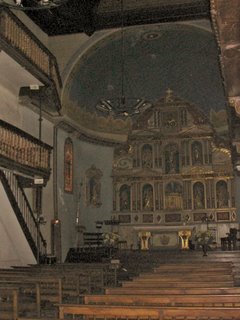 Church interior, Ainhoa
Church interior, Ainhoa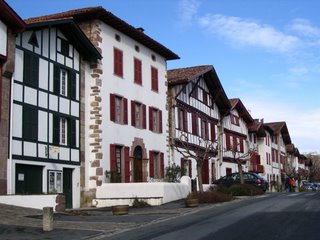 Main village street, Ainhoa
Main village street, Ainhoa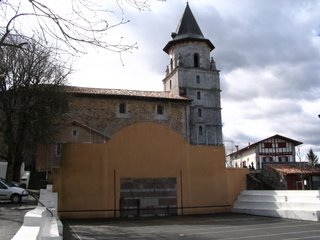 Pelote course and village church, Ainhoa
Pelote course and village church, Ainhoa Basque countryside with the Pyrenees in the distance
Basque countryside with the Pyrenees in the distanceThen on to Salies, where we stopped hopefully at the all-year campsite on the outskirts. A rough track led past angry geese and our way was barred by an obese but friendly black pot-bellied pig. Circumnavigating this porcine obstruction we found the path petering out into a soggy field with no evidence of pitches, sanitary blocks or anything that might suggest an active campsite. So we gave up and made for the centre of Salies and this comfortable self-catering apartment, just a hundred yards or so from our friends, from whom we have just returned. They have nothing but praise for the excellent French domiciliary nurses and doctors, several of whom visited Ruth while we were reminiscing with Ralph about days in Guildhall Library.
Friday 3rd March 2006, Lelin-Lapujolle, near Aire-sur-l’Adour, Gers
Here we are back in the middle of deepest France, on a rural campsite surrounded by ducks, geese, rabbits, sheep and donkeys as well as a couple of curious goats who would be nibbling at our clothes if we stayed within the range of their chains.
This morning Salies looked very picturesque in the warm sunshine. It is a beautifully little town, as described in our blog of 23rd November 2005. Outside Ralph’s home a long crocodile of children made their way to the town library, part of their regular weekly school activities.
While we breakfasted with Ralph, nurses arrived to attend to Ruth and various English friends they have got to know called to enquire after her. One friend turned out to be a retired Medical Librarian from the Department of Health who recognised Jill’s name from her website and professional contacts over the last few years! We both agreed the best thing about our jobs were that they were in the past!
After lunch we left our friends and started on the long journey back up through France towards Caen. Having followed the coast right around Spain we decided to head inland and discover parts of France still unknown to us rather than taking the coastal route through les Landes (which everyone tells us is unendingly boring), Bordeaux, La Rochelle etc. We had intended stopping at the Ile de Ré and cycling around on Hinge and Bracket. However, although it has been mild and spring-like here, winter still lies heavily across many areas of France and we would probably find the experience far from pleasant, so it will wait for another time.
So for a few hours we drove north along straight, easy roads, passing through very pleasant countryside and small, easily manageable towns. Although French drivers tend to tailgate, with the straight, flatter roads around this area, they can be fairly safely ignored and left to overtake when they can. The countryside is so very different from Spain and Portugal. It couldn’t be anywhere but France, with crumbling old stone villages, huge fields of ploughed-in stubble, roadside trees and orchards, farmsteads with fields of sheep and cattle – we saw virtually no farm animals in Spain. Beside the roads, instead of cactuses, there were creamy yellow primroses and bright celandines. The mimosa here is not quite ready to blossom and eucalyptus trees have been replaced by gnarled oaks and beeches. France really is a beautiful rural country with an amazing diversity of landscapes. We have greatly enjoyed our recent travels but both of us felt a great sense of warmth for the familiar face of France, despite all the things we have found so irritating about it at times. There is a sense of independence and anarchy about the country which both charms and exasperates!
The campsite we hoped to use turned out to be closed despite claiming to be open from March! Fortunately there was another not too far way, in the wilds of the rural countryside attached to a farm. It is very peaceful, except for the gaggling of the gees, and we need to watch out not to trip over the rabbits in the dark between Modestine and the shower block! Here the only other couple is a Welshman and his German wife on their way back to Germany. He has pleaded with us not to return to England assuring us that Modestine can have a “contrôle technique” which will make her legal here – but is invalid in England! He said he left Britain in 1992 and has never returned. He is still driving the same UK registered car with its original tax disk! He just gets it MOT’d here in France or Germany and as he doesn’t intend to return to England he doesn’t need to pay any road tax! (They don’t charge road tax over here!) He later interrupted our conversation with the campsite owner telling her we were English with too much money and no common sense, suggesting she charged us double camping fees! We have met several people who have spent over ten years just travelling around, freed from UK bureaucracy and determined never to get sucked back into the system again! We admire them, can understand how addictive such a way of life can become, but we lack the courage to join them! Besides, despite its bureaucracy, Britain does have a lot going for it and we are fortunate to have our roots in one of its most pleasant areas. There will be lots to look forward to when we finally come home.
But not the wine! That’s one of the great pleasures of travel! This evening we watched the sun sink behind the woodland on the skyline above the field of sheep, as we sipped our wine from the Loire valley and watched the huge geese waddling around the edge of their muddy pond.
Saturday 4th March 2006, Courbiac, Gers
Tonight we are beside another muddy pond in the pouring rain just south of the Dordogne region so greatly appreciated by the British.
This morning we woke to warm sunshine, ducks quacking and splashing, cockerels crowing and the scrabbling sound of a peacock attempting to land on Modestine’s roof! Peering out of the window from our bed we saw a couple of ostriches taking a morning stroll along the far side of the hedge! It really was a delightful site! To add to our pleasure, after warm showers we sat in the sunshine outside Modestine, surrounded by assorted animals as we enjoyed hot coffee and breakfast. Soon one of the rabbits followed Jill into Modestine in search of a few titbits!
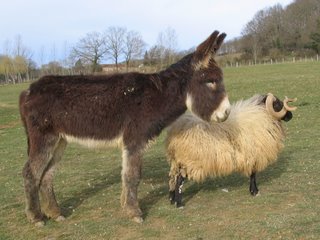 A couple of our neighbours at Lelin-Lapujolle
A couple of our neighbours at Lelin-Lapujolle A breakfast guest at Lelin-Lapujolle
A breakfast guest at Lelin-LapujolleWe were loath to leave such a peaceful place, where the buds on the cherry trees were just beginning to turn pink and primroses were showing in the hedges. We hope to return one day and explore all of this area in greater depth.
We have travelled across country on departmental roads all day and seen very little traffic. Such routes are a delight, passing through so many attractive little towns and villages and a countryside of orchards, woodland and vineyards lying in valleys or out on the flat open plains. Spring was definitely in evidence today as we passed lakes, crossed rivers and marvelled at the magnificent chateaux and mansions buried deep in this rural landscape. In so many different ways France really is a wonderfully picturesque and attractive country.
As we made our way north, for a few kilometres at Nogaro, we found ourselves back on a route we had travelled on our way back from the Basque region to Ambre-les-Espagnolettes last November. It was such a peculiar experience, remembering the thousands of miles we have driven since, never expecting to find ourselves here again! It was even stranger though, to turn off and head north, turning our backs on the road that led eventually back to the Languedoc which had been our home over the worst months of the winter.
Our first stop was at Condom. Yes, we know it has a funny name and needless to say it was one of the reasons we wanted to visit it. However, it turned out to be a very pleasant, attractive town with a magnificent flamboyant gothic cathedral with stunningly beautiful cloisters. Being lunch-time everywhere was closed and the town was silent as we wandered its pleasant little side streets. As we were leaving the cathedral a French lady with such a husky voice she made Edith Piaf sound like a nightingale, asked us if we had yet seen the cloisters. She lived locally and loved the town so much she came to walk around at lunch time when she could browse the streets, free from traffic and people.
 Reflections on the River Baïse at Condom
Reflections on the River Baïse at Condom South door of the Cathedral at Condom
South door of the Cathedral at Condom Choir of the Cathedral at Condom
Choir of the Cathedral at Condom West door of the Cathedral at Condom
West door of the Cathedral at Condom Cloisters of the Cathedral at Condom
Cloisters of the Cathedral at CondomLater we saw the lady again and told her how impressed we’d been with the cloisters. She then directed us to one of France’s most beautiful villages nearby – there is a special, regularly revised list of these and mayors will do almost anything to get their village included! In this instance however, the award was certainly well justified. It turned out to be a tiny 13th century circular bastide village. In this area bastides are fairly common. They are planned early medieval towns often with a grid pattern but Fourcés is unusual in being the only circular bastide in Gascony. Development had not got much further than a ring of arcaded half-timbered houses lying between two small rivers and clustered around a circular open space which had apparently once contained a castle but is now shaded by neatly pollarded plane trees.
 Arcaded houses at Fourcés
Arcaded houses at Fourcés Aerial view of Fourcés seen in the village museum
Aerial view of Fourcés seen in the village museumThis diversion meant that we bypassed Agen, famous for its prunes and Armagnac. Instead, we headed towards Villeneuve-sur-Lot. Our son Neil is familiar with the area having been to a friend’s wedding here a couple of years ago so we were curious to explore. However it was rush hour in Villeneuve and we did not feel inclined to linger. High on a hilltop above the town we discovered yet another of France’s most beautiful villages, Pujols. This too is a tiny, wonderfully picturesque mediaeval town of immaculate streets, large grey stone houses and a few small, timber-fronted shops. A stone well decorates the main street and there are impressive views down over Villeneuve from the town gate.
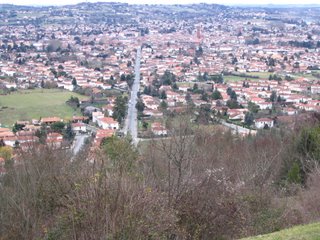 Villeneuve-sur-Lot seen from Pujols
Villeneuve-sur-Lot seen from Pujols Pujols – main street with well
Pujols – main street with wellOut into the open countryside again it began to rain and daylight started to fade quite quickly. It seems to be getting dark earlier as we move north. Our book of campsites showed this site, remotely set beside a small fishing lake. Arriving in the rain Modestine made it quite apparent that if we made her stand on wet grass overnight she had no intention of getting off again tomorrow. So the campsite has sorted us out a quite corner that is not actually one of the pitches and we have run an electricity cable out from the house just to enable us to write our blog! The weather is really mild despite the rain and we don’t need to use our electric heater tonight.
